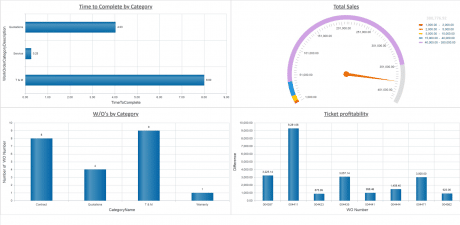Last Updated on July 3, 2024
Aug 03, 2017
For contracting businesses of all kinds, having an effective website becomes more important every day. The reason is simple — the mobile Internet. Currently, 77 percent of Americans own smartphones, and that percentage is certain to grow. Google dominates mobile search, and there are more mobile than desktop searches now being conducted. What perhaps matters most to contractors is that searches with local intent are growing twice as fast as general searches.
What this adds up to is this: People are looking for contractors online, and more and more frequently, on mobile devices. If a contracting business website turns off visitors, and mobile visitors in particular, it will fail to generate leads and new customers. So what are the key features a contracting business website must have?
They may not be what you are expecting.
1. Page Loading Speed
I’ll bet you weren’t expecting this to top the list, but page loading speed is critical to delivering a positive user experience on a website. Everyone knows the frustration of trying to get to a webpage that just won’t load — and the irritation is magnified with mobile users. Most studies indicate most users will abandon a webpage if it takes more than two or three seconds to load — and incidentally, page loading speed is a ranking factor for Google, so for any contractor engaged in SEO, slow loading will drag down results.
Page loading speed is affected by a variety of issues, such as hosting, website design and how images are handled. Contracting businesses are more vulnerable to page loading issues if they use a lot of images on their website. Images are commonly used — and very effectively if executed well — to show before/after appearance of remodeling projects, chronological progress of a construction project, etc. How images are stored and served up to website visitors has an impact on page loading; it’s important for the webmaster to review all page loading issues on a regular basis.
2. Responsive Design
Responsive website design is a technique that enables a website page to adjust automatically for optimal viewing on mobile phone, tablet and desktop screens. Without responsive design, a site’s desktop-only version will be hard to use on a mobile device, if not impossible to use. Responsive design is widely available these days; if a contractor has not yet converted from desktop-only to responsive, there is no time to waste.
The process of switching from desktop-only to responsive can be a costly project or a fairly simple transition — check with your web design firm to get an estimate. If the website platform is a popular CMS such as WordPress or Drupal, it may be a simple matter of switching templates and making a few minor design and content tweaks. Key elements of a good responsive design include:
- A click-to-call phone icon that is always in view (this really stimulates phone inquiries).
- Ultra-simple navigation, also always in view.
- Very short blocks of text.
- Lots of white space.
- Images sized for great mobile viewing.
- Simple inquiry forms with big field boxes.
A quick side note about an alternative to responsive design, a separate mobile website. Having two websites basically doubles the cost and headaches of having a single, responsive website. If a contractor has a very large staff and/or website budget, a separate mobile site may be a good option, especially if the business has tons of content on the desktop site and only needs a fraction of it on the mobile site.
3. Great Inquiry Forms
There’s no question a well-designed inquiry form will attract more leads than an average form — and a below-average form will wipe out the benefits of other strong website design features. So what constitutes a well-designed form?
- The fewer number of fields, the better. Filling out a form takes time (especially on a mobile device), and if it looks like a lot of work is involved, users won’t bother — they will literally look for another contractor website with an easier form.
- If applicable, use selection prompts to keep users from having to compose a message. For instance, have a field for “Type of Project” with a dropdown selection for Kitchen, Bathroom, etc.; and a field for “Budget” with two or three dollar ranges.
- Include an optional field where the user can compose a message. Customers often have things on their mind contractors cannot anticipate.
- Include a privacy statement reassuring users their information will not be sold or given to third parties. This is a very sensitive issue for many users; they will not submit forms if they fear by doing so they will be subjected to endless spam and telemarketing assaults.
- Make error messages very visible — when forms don’t submit and users cannot figure out why, they become quite frustrated and are likely to give up.
4. Credibility Elements
For residential contractors especially, but also for commercial firms, overcoming skepticism is a major issue in lead generation. Let’s face it: Everybody has a horror story involving home improvement delays, budget overruns, poor quality, unethical service providers and overall disasters. Contractors, more than most businesses, must devote serious attention to including credibility elements on the website. Excellent ways to do this include —
- Customer testimonials. Reviews from satisfied customers carry tremendous weight with skeptical prospects. The best testimonials include a name (a first name is sufficient for residential businesses), a company name (for commercial businesses), a location (especially for local businesses) and a brief blurb that makes a point about the firm’s quality, service or reliability. These should appear on the website home page, on a specific “What Our Customers Say” page with a link to it on the main navigation, and perhaps sprinkled throughout various service pages.
- For commercial businesses, a display of logos of recognizable customers on the home page is very powerful.
- Business facts such as years in business and number of customers demonstrate stability and reliability.
- Mention of industry awards received, BBB membership, and trade organization membership convey competence and even excellence.
5. High-Quality Photography
Producing professional photos of projects is an expensive undertaking, but well worth the expense. Images (before/after photos, project progress over time, etc.) are powerful credibility elements, and convey a contractor’s capabilities better and more powerfully than any words. In addition, with the short concentration span of mobile website users, photos may be the only parts of the website on which they really spend any time.
Quality is everything, though. Poor-quality photos don’t sell, they drive prospects away. Rightly or wrongly, amateurish photos convey a brand that is unreliable and cuts corners. Better to have one or two ultra-high-quality photos on the site than many poor ones.
Author Bio:
| Brad Shorr is Director of Content Strategy at Straight North, an Internet marketing service provider in Chicago. With more than 25 years of sales and marketing experience, Brad has been featured in leading online publications including Forbes, Moz and Entrepreneur. |







